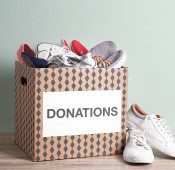When a person decides to give away money, the one question they ask–sometimes out loud–is “Who needs my donation?”
When you ask a person to support your nonprofit’s work, you have to answer that question. Otherwise, they are not going to give.
So, let’s take that key question apart.
WHO Needs My Donation?
When people give money, they want to benefit someone specific: a person or family, currently facing a problem, that will be better off with their help.
That’s it.
Donors don’t want to help your nonprofit. They don’t care about your Executive Director, your Board, your talented staff, your dedicated volunteers.
What moves them to give is that somebody is in trouble, and they can help.
Your nonprofit is not the target of their generosity. You are the channel through which it flows.
Therefore, as odd as it may seem, talking about your nonprofit is not the best way to raise money for your nonprofit. Your self-interest as an organization is to be less selfish. Get your ego out of the way, and talk about a person or family the donor will be helping, instead.
(The exceptions: donors who have a long history with your organization, who know the insiders personally, may indeed want to hear about–and from–the ED, the Board, etc. Donors who have a more institutional approach and behave more like grantmakers may want to see evidence of your effectiveness. But they are not the vast majority of people who might be willing to give…if you told them WHO they were giving to.)
Who NEEDS My Donation?
 Donations are not prizes for reaching the finish line. They are a bottle of water for people still running the race.
Donations are not prizes for reaching the finish line. They are a bottle of water for people still running the race.
Therefore, if you tell the generous person about someone who’s leaped the hurdles, overcome the obstacles, and is doing well today, they will feel great–but they will not donate. Why should they? That person doesn’t need their help!
Success stories are great to put on your communications calendar year round. They help the prospective donors get to know, like, and trust your organization, and they help first-time donors to say to themselves, “I did the right thing when I gave. My donation made a difference.”
When you are asking for money, don't reach the finish line. Share on XIn your appeal letter or fundraising email, tell the story of a person or family, currently facing a problem, that will be better off with their help.
Currently facing. Will be better off, in the future, if the donor gives.
Create a sense of need if you want the donor to feel the urgency personally.
Who Needs MY Donation?
The great thing about telling success stories year round is that it helps donors and prospects feel they are not alone. If they give, they join a group of like-minded people who have already given. Their donation makes a difference, and it doesn’t have to make all the difference.
What’s great for year-round communication is deadly for your fundraising appeal.
At the moment the person is making the decision whether or not to give, they need to feel like everything depends on them. The person or family currently facing a problem is ready to topple into the abyss, and you, the donor, can reach out and give them the hand they need.
Notice! You are getting your organization out of the middle. The connection you are forging is a direct connection between the person who needs the help and their partner, the donor. Also notice: you are focusing on the present moment, to the exclusion of everything else. (The thank-you letter will be a good place to move toward the happy ending of the story!)
Who Needs My DONATION?
 It’s not enough to say “This person needs your help.” You must also say, “Give now.”
It’s not enough to say “This person needs your help.” You must also say, “Give now.”
Yes, you must ask for money in so many words. People won’t make that decision to give unless you do–and more than once in every fundraising appeal.
And you must suggest a donation level, because if you don’t, the donor won’t know what you expect. You can use the classic “$50 will do this, $250 will do that” approach. Even better: you can know the donor well enough and use sensitive enough software to ask them for just a bit more than they gave the last time.
If you focus on a person or family, currently facing a problem, that will be better off with their help, you may gain the person’s attention and win their heart. That is not enough. Thoughts and prayers won’t do it. You need to ask for the money that will really help. Only then will you, the donor, and the person they mean to give to all be on the same team.



